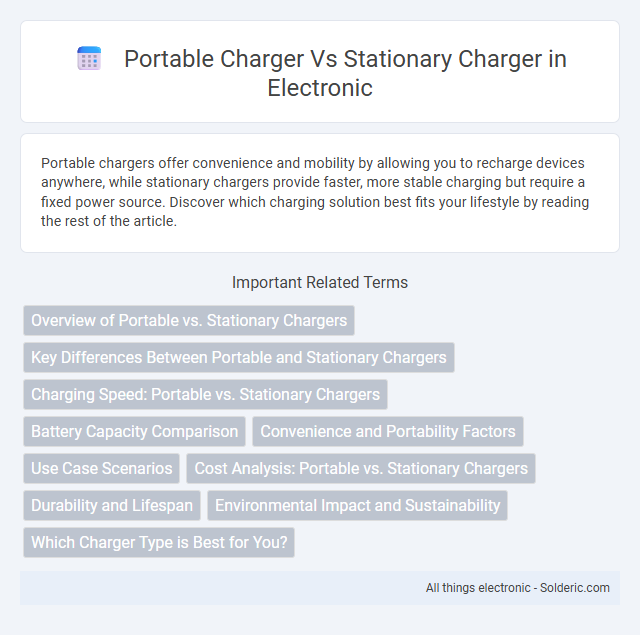Portable chargers offer convenience and mobility by allowing you to recharge devices anywhere, while stationary chargers provide faster, more stable charging but require a fixed power source. Discover which charging solution best fits your lifestyle by reading the rest of the article.
Comparison Table
| Feature | Portable Charger | Stationary Charger |
|---|---|---|
| Mobility | High - easy to carry and use anywhere | Low - fixed installation, not movable |
| Power Source | Battery-powered, recharged via USB or outlet | Direct AC power connection |
| Charging Speed | Moderate to fast, depends on battery capacity and output | Fast, continuous power supply |
| Capacity | Limited by internal battery size (mAh) | Unlimited while connected to power |
| Use Case | Travel, outdoor, emergency charging | Home, office, fixed location charging |
| Cost | Generally lower upfront cost | Higher initial cost but durable |
| Size & Weight | Compact and lightweight | Larger and heavier |
| Device Compatibility | Universal via USB ports, some support wireless charging | Wide compatibility, multiple device charging possible |
Overview of Portable vs. Stationary Chargers
Portable chargers offer the convenience of on-the-go power supply with compact designs and built-in batteries, suitable for smartphones, tablets, and other small electronics. Stationary chargers provide a consistent and higher power output, ideal for home or office use with devices that require longer charging times or higher wattage. Choosing between portable and stationary chargers depends on mobility needs, power capacity, and device compatibility.
Key Differences Between Portable and Stationary Chargers
Portable chargers offer mobility and convenience, allowing you to power devices on the go with built-in batteries and compact designs. Stationary chargers provide consistent, high-capacity charging typically used in fixed locations like homes or offices, featuring direct power connections and faster recharge rates. Your choice depends on whether you prioritize portability and flexibility or stable, rapid charging for multiple devices.
Charging Speed: Portable vs. Stationary Chargers
Stationary chargers typically provide faster charging speeds due to higher power output and enhanced cooling systems, enabling rapid recharging of devices. Portable chargers, while convenient for mobility, often have lower wattage, resulting in slower charge times compared to their stationary counterparts. Your choice depends on whether quick power replenishment or on-the-go convenience is the priority.
Battery Capacity Comparison
Portable chargers typically offer battery capacities ranging from 5,000mAh to 30,000mAh, making them ideal for on-the-go device recharging. Stationary chargers, often designed as charging stations or docks, rely on direct power supply instead of internal batteries, providing consistent charging without capacity limitations. The key difference lies in portability and capacity dependency, with portable chargers constrained by their internal battery size while stationary chargers deliver continuous power.
Convenience and Portability Factors
Portable chargers offer unmatched convenience and portability, allowing users to charge devices on the go without the need for power outlets. Their compact size and lightweight design make them ideal for travel, outdoor activities, and emergency use. In contrast, stationary chargers provide faster charging speeds but require a fixed location, limiting mobility and ease of use outside the home or office.
Use Case Scenarios
Portable chargers excel in providing on-the-go power for smartphones, tablets, and small devices during travel, outdoor activities, or emergency situations without relying on wall outlets. Stationary chargers are ideal for consistent, high-capacity charging needs at fixed locations like homes or offices, supporting devices such as laptops or electric vehicles with faster and more stable power delivery. The choice depends on mobility requirements and power demands, with portable chargers offering convenience and flexibility, while stationary chargers deliver reliability and efficiency.
Cost Analysis: Portable vs. Stationary Chargers
Portable chargers typically cost between $20 and $100 depending on capacity and brand, while stationary chargers, such as wall-mounted EV chargers, range from $300 to $1,200 including installation fees. The initial investment for stationary chargers is higher but offers faster charging speeds and long-term convenience, potentially reducing overall energy costs. Portable chargers provide mobility and lower upfront costs but may require longer charging times and depend on external power sources.
Durability and Lifespan
Portable chargers typically feature durable, impact-resistant casings designed for frequent transport and outdoor use, contributing to a longer lifespan despite constant movement. Stationary chargers, often housed in more robust materials and fixed setups, benefit from stable operating environments that reduce wear and tear, potentially extending overall durability. Both types rely on high-quality lithium-ion or lithium-polymer batteries, but portable chargers may experience faster capacity degradation due to temperature fluctuations and physical stress compared to stationary units.
Environmental Impact and Sustainability
Portable chargers reduce environmental impact by minimizing the need for multiple charging points, promoting energy efficiency through on-the-go power management, and often integrating solar or renewable energy options. Stationary chargers typically demand consistent electricity supply, which can contribute to higher carbon footprints if powered by non-renewable energy sources. Choosing your charger with sustainable materials and energy-efficient technology supports longer device lifespan and reduces electronic waste.
Which Charger Type is Best for You?
Portable chargers offer mobility and convenience, allowing you to charge devices on-the-go without needing an outlet, making them ideal for travel or emergencies. Stationary chargers provide faster charging speeds and stable power supply, suitable for home or office use where portability is less important. Your choice depends on whether you prioritize flexibility and portability or faster, reliable charging in a fixed location.
portable charger vs stationary charger Infographic

 solderic.com
solderic.com